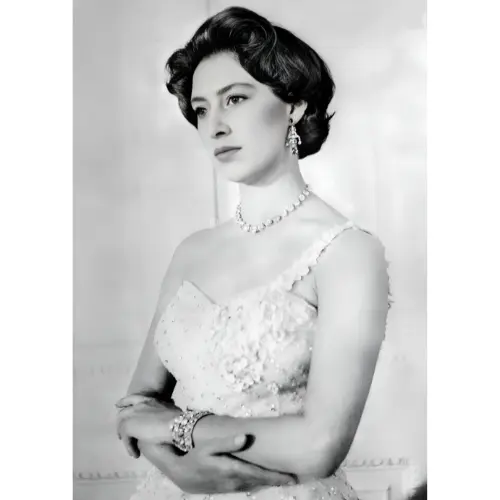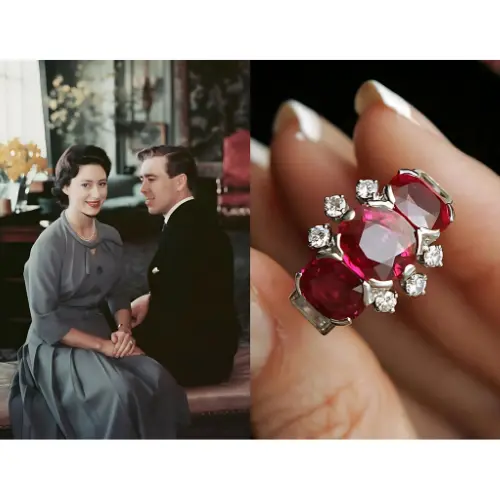
Princess Margaret of England captivated the world with her magnetic personality, often described as both enchanting and rebellious. Renowned for her wild child nature, she defied convention and embraced a lifestyle marked by boldness and indulgence. Yet, amidst her flamboyant demeanor, Princess Margaret possessed an undeniable charm and sophistication that captivated all who encountered her.
One of her most notable passions was her love for jewelry, which she adorned with flair and elegance. Each piece she wore seemed to reflect her vibrant spirit and unapologetic sense of style. From grand tiaras to intricate necklaces, Princess Margaret's affinity for jewels was a reflection of her penchant for the finer things in life and her unwavering commitment to making a statement wherever she went. Here are some highlights from her jewelry collection:
Poltimore Tiara:

The Poltimore Tiara, crafted in the 19th century, was acquired by Princess Margaret in 1959. This exquisite piece boasts diamond festoons and large pearls, embodying Victorian-era jewelry style with its intricate diamond scrolls reminiscent of flora and nature. Originally belonging to Lady Poltimore, wife of the second Baron Poltimore, it was made in 1870 by the House of Garrard in London. Lady Poltimore adorned it at the coronation of King George V in 1911.
.webp)
Despite having access to royal jewels, Princess Margaret sought a personal treasure. She purchased the tiara at auction for £5,500, showcasing it prominently at her wedding to Antony Armstrong-Jones in 1960. Its versatile design allowed for transformation into a necklace or various brooches.
The tiara's delicate framework, woven with brown ribbon to match Margaret's hair, creates an illusion of weightlessness when worn, accentuating the brilliance of its jewels. Following Margaret's passing in 2002, Christie's auctioned her private collection, including the Poltimore Tiara, which sold for £926,400 to an undisclosed buyer. Its current whereabouts remain unknown.
The Lotus Flower Tiara:
.webp)
The tiara known as the Lotus Flower derives its name from the prominent lotus flower (or papyrus leaf) motifs adorning it, and its history intertwines with several generations of the British royal family. Initially worn by the Queen Mother, it originated from a necklace gifted to her by her husband, George VI, for their wedding in 1923. Despite its significance, Queen Elizabeth decided to repurpose the necklace's diamonds and pearls, leading Garrard to transform it into the iconic tiara just six months later.
Princess Margaret, the Queen Mother's daughter, inherited the tiara in 1959 from her mother. It became one of her most frequently worn pieces, alongside the Poltimore Tiara, notably gracing her appearance at her wedding to Antony Armstrong-Jones. Following Margaret's passing, the tiara's ownership remained a topic of speculation among jewelry enthusiasts.

In a surprising turn of events in December 2013, the Duchess of Cambridge, Kate Middleton, brought the Lotus Flower tiara back into the limelight. She wore it at the annual diplomatic reception and again in 2015 for a state banquet honoring the President of China. Notably, she adorned the tiara once more at the Diplomatic Reception in December 2022, continuing its legacy into a new era.
Speculation surrounding the tiara's ownership was resolved with the revelation that Princess Margaret returned it to the royal vaults, either before her death or through her will. Consequently, the Lotus Flower tiara remains cherished by successive generations of Windsor women, ensuring its continued prominence within the royal jewelry collection.
The Snowdon Floral Tiara:

Originally, the tiara emerged from a set of three diamond floral brooches, presented to Princess Margaret by Antony Armstrong-Jones as a wedding gift in 1960. These brooches boasted diamond-set petals and leaves arranged on branches, featuring naturalistic elements with edges that conveyed a sharp, distinct appearance rather than soft, romantic floral designs. Eight years later, the brooches underwent a transformation into a new jewelry piece: a tiara intended for Margaret's daughter, Lady Sarah Armstrong-Jones. At her wedding to Daniel Chatto in July 1994, Lady Sarah adorned the tiara, specially crafted by Wartski for the occasion. The amalgamation of the brooches into a tiara provided a unique floral adornment for the bride, who chose to enhance the diamonds with a wreath of greenery, infusing a touch of genuine nature into the diadem.
Princess Margaret’s Ruby and Diamond engagement ring:

Princess Margaret's engagement ring stood out as a distinctive royal piece. Lord Snowdon, formerly Antony Armstrong-Jones, crafted the design, featuring a ruby center stone encircled by cut diamonds arranged to resemble flower petals, evoking the appearance of a rosebud. This design choice held sentimental significance, paying homage to Princess Margaret's middle name, Rose.
The centerpiece of the ring showcased a high-grade Burmese ruby, distinguished by its deep, dark red hue, making it rarer than Princess Margaret's ring's center stone. However, despite its rarity, the deeper tone of the Burmese ruby wouldn't carry the same sentimental weight as Princess Margaret's lighter-hued center stone.
Set in platinum and mounted on a yellow gold band, the engagement ring boasted a classic yet elegant design, enhancing its timeless appeal. Princess Margaret's ring remains a unique symbol of love and sentimentality within the realm of royal jewelry.
The Persian Turquoise Parure:

The Turquoise Parure, comprising a tiara, necklace, brooch, and earrings adorned with diamonds and large Persian Turquoises, holds a significant place in royal jewelry history. Queen Mary purchased this exquisite set from Garrard, gifting it to Lady Elizabeth Bowes-Lyon upon her wedding in 1923.
During the 1920s and 1930s, the Duchess of York frequently adorned herself with the Turquoise Parure, considering it her most substantial jewelry collection. She often wore both the complete set and its individual elements, showcasing their timeless elegance and grandeur. However, following her husband's ascension to the throne in 1937, these jewels were no longer publicly displayed.
In 1951, Queen Elizabeth, the Queen Mother, bestowed the Turquoise Parure upon her younger daughter, Princess Margaret, as a cherished 21st Birthday gift. Princess Margaret proudly wore these jewels at various events following her father's passing, including some official portraits, highlighting their enduring beauty and royal legacy.
The Queen Mary Diamond Rivière:
.webp)

Originally belonging to Queen Mary, the "diamond riviere of 34 stones" necklace features old-cut diamonds set in a silver and gold necklace dating back to around 1900. Notable for its seven largest diamonds measuring between four and seven carats each, it comprises a single row of large diamonds. Eventually, Queen Mary either gifted or bequeathed the necklace to Princess Margaret. Consequently, it's sometimes referred to as "Queen Mary's Diamond Riviere," but more commonly known as the "Lady Mount Stephen Necklace." Princess Margaret often adorned herself with this exquisite piece for formal occasions.
The Cartier Halo Tiara:
.webp)
In 1944, Queen Elizabeth gifted the Halo Tiara to her daughter, the late Queen Elizabeth II, for her 18th birthday. During the wartime austerity of Princess Elizabeth's youth, most of her jewelry gifts were hand-me-downs. Though Princess Elizabeth didn't wear her birthday tiara publicly, she often lent it to her sister, Princess Margaret. Margaret first wore the tiara during Queen Juliana of the Netherlands' inauguration celebrations in 1948 and later at her sister's coronation in 1953. The tiara, featuring diamond scrollwork set in platinum, suited Princess Margaret perfectly in size and style. She frequently wore it before and after her marriage to Antony Armstrong-Jones, opting for grander pieces like the Poltimore Tiara later on.
In conclusion, Princess Margaret's legacy is one of unparalleled elegance, rebellion, and a profound love for jewelry that continues to captivate generations. Through her magnetic personality and daring spirit, she left an indelible mark on the world, challenging norms and embracing life with unbridled passion. Her penchant for adorning herself with exquisite jewels was not merely a display of opulence, but a reflection of her vibrant persona and unwavering commitment to self-expression. Princess Margaret's story will forever shine bright, a testament to the enduring enchantment of royalty and the timeless beauty of a life lived boldly.
You may also like:
QUEEN ELIZABETH II: A LEGACY OF GRACE AND RESILIENCE
QUEEN VICTORIA'S ENDURING LEGACY: THE PROFOUND INFLUENCE OF MOURNING JEWELRY IN THE VICTORIAN ERA
KATE MIDDLETON'S ICONIC JEWELRY: A ROYAL TAPESTRY OF ELEGANCE AND TRADITION







